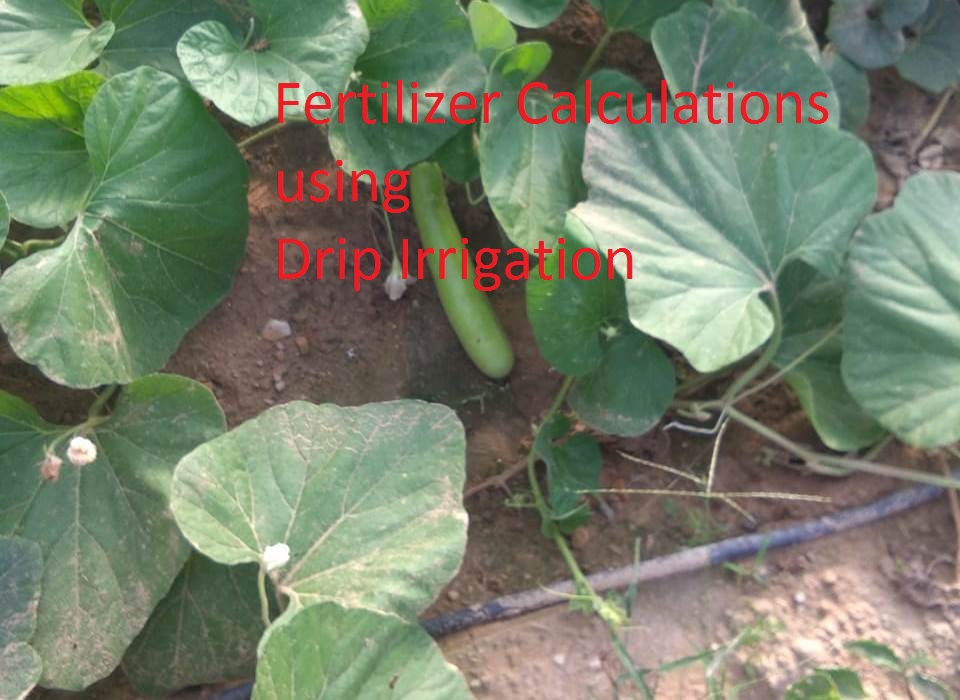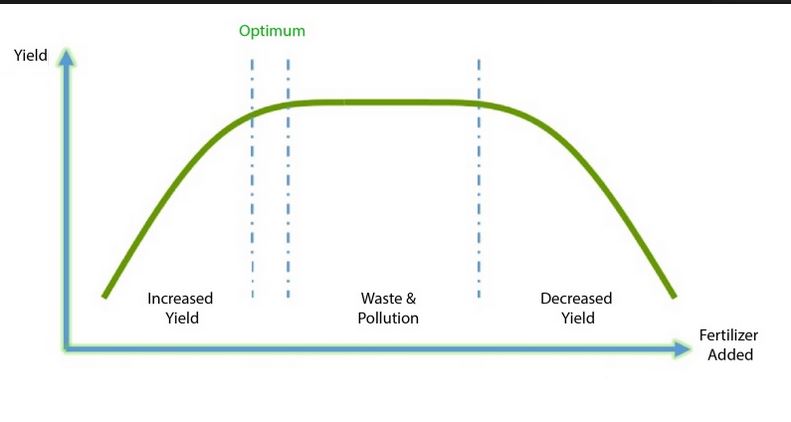In Fertigation, fertilization calculations are done in PPM (parts per million) of various elements used as fertilizers. Fertilizer calculations also involve discharge rates of drip water and dilution rate of fertilizer injectors. Also it involves knowledge, self-acquired or from reliable sources, on the suitable PPM rates for particular crops.
I would like to first go into what is Fertigation, why Fertigation and how of Fertigation. Then I bring out a formula for calculating the amount of fertilizer for desired PPM in the nutrient solution. This formula is not the panacea for all things; however it enables the farmer for his calculations to a great degree.
What is Fertigation? Two things have to be present for this term to be used. One the farmer is using the drip technology to irrigate his crop(s). And, two, the farmer is using the drip lines to provide fertilizers to his crops.
The method of fertilizing through drip lines is called Fertigation.
a recap of drip irrigation
Before we proceed to Why and How of Fertigation, my previous article Fertigation would be a good read.
- Application of water at low pressure
- Drop by drop over a long time
- prevents evaporation and spreading of water,
- directed to the roots of plant,
- economy of water,
- economy of fertilizers,
- used in undulated or difficult terrain,
- efficient use of scare water yielding water saving, improved quality of crop,
When we use drip irrigation to provide fertilizers and soil insecticides through drip, as mentioned before as FERTIGATION, we get additional advantages.
Advantages of Fertigation
- The Fertigation allows applying the nutrients exactly and uniformly only to the wetted root volume, where the active roots are concentrated.
- Increases the efficiency and efficacy of the fertilizer.
- Results in reducing the amount of fertilizer required.
- Reduces not only production costs but also lessens groundwater pollution caused by the fertilizer leaching.
- Fertigation allows planning and delivery of only the required amounts of the applied nutrients to the crop throughout the growing season.
- Crop foliage can be kept dry avoiding leaf burn and delaying the development of plant pathogens.
The optimal curve of consumption of nutrients defines the minimal application rate of a certain nutrient that is required to maintain a constant nutrient concentration in the soil solution.
In comparison to all other irrigation methods, Fertigation is not optional.
That answers the WHY part of this blog.
The HOW part of blog is well answered in my article on Fertigation. But let us discuss it some more here.
Fertilizers solubility
Fertigation requires that fertilizer dissolves completely in irrigation water. Some highly soluble fertilizers appropriate for use in Fertigation are: Ammonium Nitrate, Potassium Chloride, Potassium Nitrate, Urea, Ammonium Monophosphate and Potassium Monophosphate.
The solubility of fertilizers also depends on the temperature. In summers higher density solutions may be made but in winters leaner solutions would need to be made.
| Solubility of fertilizers gm./liter indicative figures only | ||
| Fertilizer / Temperature (C˚) | 10 | 20 |
| Potassium nitrate | 170 | 209 |
| Ammonium nitrate | 1510 | 1920 |
| Ammonium sulfate | 730 | 750 |
| Calcium nitrate | 1130 | 1290 |
| Magnesium Nitrate | 690 | 710 |
| MAP (Mono Ammonium Phosphate) | 295 | 374 |
| MKP (Mono Potassium Phosphate) | 180 | 230 |
| Potassium chloride | 238 | 255 |
| Potassium sulfate | 90 | 111 |
| Urea | 850 | 1060 |
Some factors to decide on the injector equipment required for regulating Fertigation in drips are:
- quantity of fertilizer to be applied
- duration of applications
- proportion of fertilizers
- starting and finishing time
Fertilizer recommendations are generally given in parts per million (ppm) of N or P or K or a combo in the final solution being applied to the crop.
Explanation
Most growers use injectors of one type or other for applying fertilizers to greenhouse crops. Injectors “inject” a specific amount of concentrated fertilizer solution (stock solution) per increment of irrigation water that passes through the injector. An important attribute of each fertilizer injector is the injector ratio, which is defined as volumetric ratio of stock solution to dilute fertilizer solution.
Injector ratio – the volumetric ratio of stock solution to dilute fertilizer solution.
Popular injector types:
- Pressure differential (by-pass tank)
- Vacuum injection (Venturi) – very popular
- Pump injection – very precise
Determination of particular fertilizer quantity for required PPM at the root zone.
Step one in any Fertigation program is to first have a soil and water analysis done for determining the EC, pH and quantities that may be present of minerals in your water and soil.
Second step is to determine the nutrient rates your crop requires. You can use recommendations from the literature, or your own experience. If nutrient requirements are provided in units other than ppm or mg/l, it is recommended to convert the values to ppm (1ppm = 1 mg/l).
Deduct the soil water test results from the nutrient requirements of the crop for each required nutrient. For example, if magnesium requirement is 60 ppm and the source water contains 40 ppm, and then 60-40=20 ppm of magnesium has to be added to each liter of nutrient solution.
Fertilizer Selection
Farmer needs to go through all Fertilizers available with him or in nearby store. And then select ones which contain all nutrients needed to be added. Begin with the fertilizer that contains a unique nutrient that other fertilizers do not contain. For example, if the only available source of calcium you have is calcium nitrate, start the calculation with this fertilizer.
Now we come to nuclear question. By now farmers has decided on what should be fertilizer ppm in the drip solution delivered to his plants. How do we measure the amount of fertilizer(s) for making the stock solution which would provide desired PPM at delivery point? Let us continue.
What are those numbers on the bag
Check the numbers of your fertilizers. N P K. the fertilizers bag would be printed as 20-20-20 or 20-10-10 or even 52-34-0 and 0-0-62. The first, second and third numbers indicate the percentages of elemental Nitrogen, Phosphorus in the oxide form (P2O5) and Potassium in the oxide form (K2O), respectively.
Calculate Fertilizer Amounts
The formula allows you to calculate the amount of fertilizer needed to mix stock solutions. This formula can be used with any injector ratio, any desired concentration of diluted fertilizer solution and for all common units of measurement.
Note:
- Dilution factor is the reverse of injector ratio i.e. if injector ratio is 1:100, the dilution ratio is 100.
- K is a conversion constant depending on the units used.
- K = 75 if units are ounces per gallon
- K = 1200 if units are pounds per gallon and
- K = 10 if units are grams per liter.
Example
Farmer has an injector with a 1:200 ratio and a fertilizer with an analysis of 20-20-20. He wants to apply 150-ppm nitrogen as a constant feed. How many ounces of fertilizer would he have to weigh out to make 1 gallon of stock solution?
1. Given
- Desired concentration = 150 ppm
- Injector ratio = 1:200; dilution factor = 200
- Fertilizer analysis = 20-20-20 (20-percent nitrogen)
- Ounces of fertilizer to make 1 gal. of stock solution = X (unknown)
- Units: ounces per gallon. Use 75 as the conversion constant K.
2. Perform calculation:
X = (150-ppm nitrogen x 200) / (20-percent nitrogen X 75) =30,000 / 1500 = 20 oz. per gal.
3. Answer:
Add 20 oz. of 20-20-20 to a stock solution bucket and fill to the 1-gal. Farmer can have as many gallons of stock solutions and feed it through his injector in the drip line till his crop is served. He will always have the same 150 PPM of N.
Readers may like to experiment to get result in gms per liter of stock solution using the same formula with K = 10.
Additional information
MKP 0-52-34 contains 52% P2O5 and 34% K2O. MAP 11-52-0 contains 11% N and 52% P2O5. To calculate the rate of the fertilizer required to apply certain concentrations of P and K, you should first convert %P2O5 and % K2O to elemental P and K by multiplying by 0.4364 and 0.8302 respectively. N is 1.
Nitrogen may be applied in two different forms – nitrate (NO3–) and ammonium (NH4+). The ratio between these two forms is of a great importance in nutrient solutions. Therefore, you may want to break down the nitrogen calculation to these two forms. MAP (mono ammonium phosphate) contains 12% N-NH4, while potassium nitrate contains 13% N-NO3.
This means the nitrogen in MAP is in its ammonium form, while in potassium nitrate it is in the nitrate form. Some fertilizers may contain both forms.
Often, the pH of the nutrient solution has to be lowered. This is done by adding acid to the nutrient solution.
Please do share if you know or practice any other formula for calculations.



Sir,I want to know the ratio of soluble fertilizers in place of Granules through drip irrigation…suppose 1 100kg granules is equal to what quantity of soluble fertilizers..?? PL.OBLIGE in simple language….
Thank you Mr Veeresh. For drip irrigation only soluble or liquid fertilizers are used. re yr query, if the composition of fertilzers in granular and soluble fertilizer form is same, rate of application would be similar. for more clarification could you please email with specific details.
What are the ratio of npk in 1000 litres of water
It depends on the type of npk fertiliser used. please follow calculations given in the blog.
Can you recommend an eductor brand for use with a 35 PSI drip irrigation system for a small garden say 200 1-gal/hr drippers and typical 50 gallon watering.
I am sorry could not understand eductor brand and of what item. I feel you are looking for a suitable pump to run your small drip system. I suggest you please go through my blog on the same site “How to choose a Pump Motor”. You have to use the formula to find the Bhp of the pump motor. If you inform depth of water source, height of lift required, types of pipe used, I would show you the calculations. Brand can be decided depending on country of use.
regarding brand which country you are from will decide this issue. thank you for your great interest in my blogs.